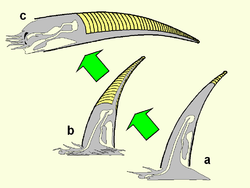Treptoceras fossil nautiloid, Ordovician of Kentucky
Treptoceras fossil nautiloid (4.8 cm across) in calcisiltite from the Ordovician of Kentucky, USA.
This is a partial internal mold of a Treptoceras nautiloid cephalopod. The living animal was a squid-like creature that constructed a long, slightly tapering, aragonitic, hollow shell with regularly-spaced internal walls. The original aragonite shell has dissolved away, leaving an internal mold (impression of the shell's interior). Nautiloids were relatively common components of Paleozoic oceans. Most species had straight, slightly tapering shells, but some had loosely cosusiled or tightly coiled shells The entire group is represented in today's oceans by three living species of chambered nautilus - Nautilus pompilius, Nautilus macromphalus, and Allonautilus scrobiculatus.
Classification: Animalia, Mollusca, Cephalopoda, Nautiloidea, Orthocerida
Stratigraphy: Kope Formation, Edenian Stage, lower Cincinnatian Series, Upper Ordovician
Locality: loose piece from roadcut along the northeastern side of the AA Highway, immediately southeast of the Rt. 154 intersection, west-southwest of the town of Moscow (Ohio), northern Kentucky, USA (38° 50' 13.65" North, 84° 15' 36.81" West)Relevante Bilder
Relevante Artikel
NautiloideenDie Nautiloideen (Nautiloidea) sind eine Teilgruppe der Kopffüßer, die bis auf eine heute überdauernde Familie, die Perlboote (Nautilidae), ausgestorben ist. Das Taxon war mit etwa 800 bekannten Gattungen sehr formenreich. 90 % davon lebten im Erdzeitalter des Paläozoikum, in der Trias kamen noch etwas über 30 Gattungen vor, etwa 26 im Jungmesozoikum, 9 im Paläogen und 3 im Neogen. Heute leben noch zwei Gattungen, Nautilus mit vier Arten und Allonautilus mit einer Art. Beide kommen im zentralen Indopazifik von den Philippinen bis Samoa vor. .. weiterlesen




